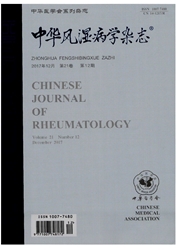

 中文摘要:
中文摘要:
目的了解SSc患者毛细血管扩张的患病率,分析与其他临床特点相关性,以评判毛细血管扩张是否可提示SSc病情的严重程度。方法选择在北京协和医院诊治的欧洲抗风湿病联盟硬皮病研究协作组(EUSTAR)数据库中的154例SSc患者。入选患者均符合1980年ACR的SSc诊断标准。对体格检查中有毛细血管扩张患者的病程、临床表现、实验室检查等指标与未出现毛细血管扩张的患者进行比较。应用矿检验,t检验或Mann—WhitneyU检验进行统计学分析。结果154例患者中,63例(40.9%)患者伴有毛细血管扩张。有毛细血管扩张的SSc患者较无毛细血管扩张的患者更易出现指(趾)硬化[分别为96.8%(61/63)、85.7%(78/91)]、面颈部皮肤硬化[分别为73.0%(46/63)、56.0%(51/91)]、指端溃疡[分别为36.5%(23/63)、14±3%(13/91)]、指垫消失/指尖凹陷性瘢痕[分别为50.8%(32/63)、33.0%(30/91)],差异均有统计学意义(矿值分别为5.228,4.600,10.263,4.919;P值分别为0.022,0.032,0.001,0.027)。有毛细血管扩张的SSC患者肺功能指标中的用力肺活量占预计值百分比[(77.3±2.2)%]、肺泡通气量[(1.68±0.22)L]均小于无毛细血管扩张的SSc患者[分别为(84.7±1.9)%,(2.47±0.29)L],差异均有统计学意义[t=2.533,2.032;p=0.013,0.046]。结论中国SSc患者中毛细血管扩张并不少见,常伴有指端溃疡、肺功能恶化,可能提示SSc患者病情进展和加重。
 英文摘要:
英文摘要:
Objective To estimate the prevalence of telangiectasia in patients with systemic sclerosis (SSc), and to analyze the relationship of telangiectasia with the severity of SSc. Methods One hundred and fifty-four Chinese patients with SSc were included in this study at Peking Union Medical College Hospital (PUMCH), which is one center of EULAR Scleroderma Trial anal Research group (EUSTAR) in China. All patients fulfilled the American College of Rheumatology (ACR) for SSc. Demographics, symptoms, signs and aboratory findings were collected for all patients. The data were compared between patients who had telan- giectasia and those who had not. Chi-square test, t-test and Mann-Whitney U test were used to analyze the data. Results The prevalence of telangiectasia in the 154 patients of SSc was 40.9% (63/154). While compared with patients who did not have telangiectasia, patients who were complicated with telangiectasia had more sclerosing fingers (toes) [96.8% (61/63), 85.7% (78/91), respectively], thicken skin of face and neck [73.0%(46/63), 56.0%(51/91), respectively], finger tip ulcers [36.5%(23/63), 14.3%(13/91), respectively], shrinked finger pad/fingertips depressed sear [50.8% (32/63), 33.0% (30/91), respectively(x2=5.228, 4.600, 10.263, 4.919; P=0.022, 0.032, 0.001, 0.027, respectively). FVC% and VA were decreased in patients with telangieetasia I (77.3±2.2)% vs (84.7±1.9)%, (1.68±0.22) L vs (2.47±0.29) L] (t=2.533, 2.032; P=0.013, 0.046). Conclusion Telangiectasia is a common sign in patients with SSc in China. Patients with telangieetasia are susceptible to fingertip ulcers and pulmonary function impairment. Therefore, attention should be paid to SSc patients presented with telangiectasia.
 同期刊论文项目
同期刊论文项目
 同项目期刊论文
同项目期刊论文
 Prevalence and clinical importance of gastroesophageal reflux in Chinese patients with systemic scle
Prevalence and clinical importance of gastroesophageal reflux in Chinese patients with systemic scle 期刊信息
期刊信息
